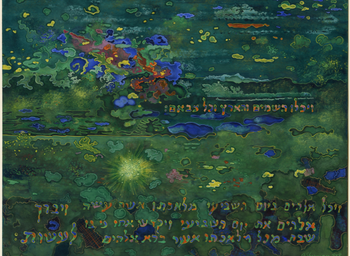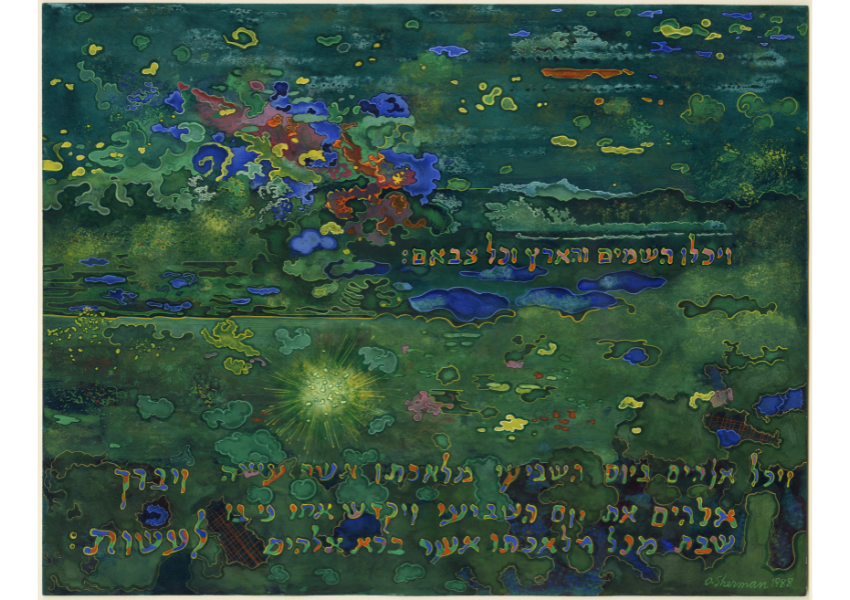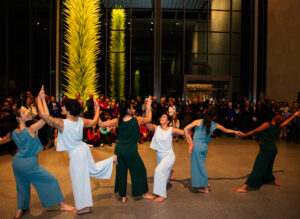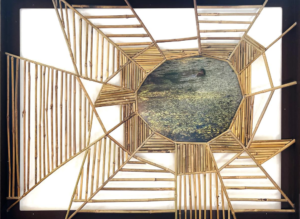Visual Torah and Risk Literacy: Ori Sherman’s 7th Day of Creation in the Age of Global Pandemics
Published Sep 23, 2022

Creation according to Ori Sherman

Ori Sherman (Jerusalem, 1934–San Francisco, 1988), an artist and illustrator beloved in the San Francisco Bay Area, often focused on Jewish themes.
Sherman was born in Jerusalem and grew up in Brooklyn, in a Jewish Reconstructionist community following the teachings of Rabbi Mordecai Kaplan (1881-1983). After graduating from the Rhode Island School of Design in 1955, he served in the US Army but was dishonorably discharged because he was gay – a discharge he later fought through legal means, leading to his reinstatement in 1984. In 1958 he moved to San Francisco, working as a rather original picture-frame finisher: his frames, along with furniture and other objects, were painted with colorful decorative motifs, which created around him a following of local, devoted patrons.
Jewish identity was central to Ori Sherman as a source of visual and moral inspiration. In a short autobiographical profile, he wrote: “My early upbringing created the climate which allowed me, later in life, to swim comfortably against the tide both in my artwork and in my personal life. I was taught to act on the advice of my own conscience. The [Rabbinic] dictum, ‘Where there are no men, be a man yourself’ [Mishnah, Avot, 2:5], appeals to me greatly and I try to honor it.”
At the end of his life, he completed a cycle of 18 paintings illustrating the Creation along with the Hebrew text from Genesis. These highly original artworks will be displayed by The Magnes Collection in Berkeley for the very first time in the Fall of 2022.
I consider Sherman’s “Creation” a paramount contemporary example of “visual Torah:” the depiction of scripture through graphic art and objects of material culture. This practice, common in traditional Jewish visual culture, shapes a corpus of unusual and piercing commentaries on the Bible itself and its words, and often prompts a different understanding of passages that are intricate from literary and theological points of view.
Sherman’s “Creation” closely follows the narrative of Genesis—and includes its Hebrew words as generative graphic elements—day in and day out, from the tohu vavohu (unformed void) that precedes light on the First Day, to the rest of the first Shabbat. While completing this highly imaginative project, Sherman was diagnosed with HIV/AIDS, at the peak of a pandemic that is still with us after four decades and that offers important clues on how to relate to the current one (Covid-19).
Sherman died in 1988, hours after completing the “Creation”. In the painting describing (and interpreting) the Seventh Day, as the creation is accomplished, he illustrated a cosmos complete with a rainbow of organisms. In it, it is not difficult to spot what may very well be a virus—microphotography in the 1980s offered detailed views of whole cells under the attack of the HIV virus, but visualizations of the virus itself (unlike that of SARS-CoV-2, identified in Wuhan, China, in 2019) were still somewhat speculative.
Above:
Ori Sherman (Jerusalem, Palestine, 1934 – San Francisco, California, 1988)
vayekhulu hashamayim veha-aretz vekhol tzevaam… (Gen. 2:1-3) from The Creation (1986-1988)
Gouache on paper
San Francisco, California, 1988
Gift of Charles M. Little, The Magnes Collection of Jewish Art and Life, University of California, Berkeley, 2006.4.1.17
License: https://creativecommons.org/licenses/by-nc-sa/2.0/
Francesco Spagnolo is the Curator of The Magnes Collection of Jewish Art and Life and an Associate Adjunct Professor in the Department of Music at the University of California, Berkeley. A multidisciplinary scholar focusing on Jewish studies, music, and digital media, he intersects textual, visual, and musical cultur...
Reflections
For readers of the Bible
Do you ever try to "picture" in your mind what the Bible describes? How would you deal with words, or entire sections, that are difficult to decipher? Do images simplify or complicate your understanding?
For anyone concerned with Pandemics
Does it make sense to think that the world was created with deadly viruses in it? What do you think of art that engages with this today? How does reflecting on the now 40-year-old HIV/AIDS pandemic help in navigating our world today? Have you heard (or considered) the expression "risk literacy"?
For artists
If you engage with the Torah, how close do you feel you want, or need, to be to its texts and interpretations? Would you consider reading traditional and new commentaries, and/or engaging with Rabbis and biblical scholars as you reflect on the words of the Jewish Bible?
New
Want more?
Get curated JewishArts.org content in your inbox





